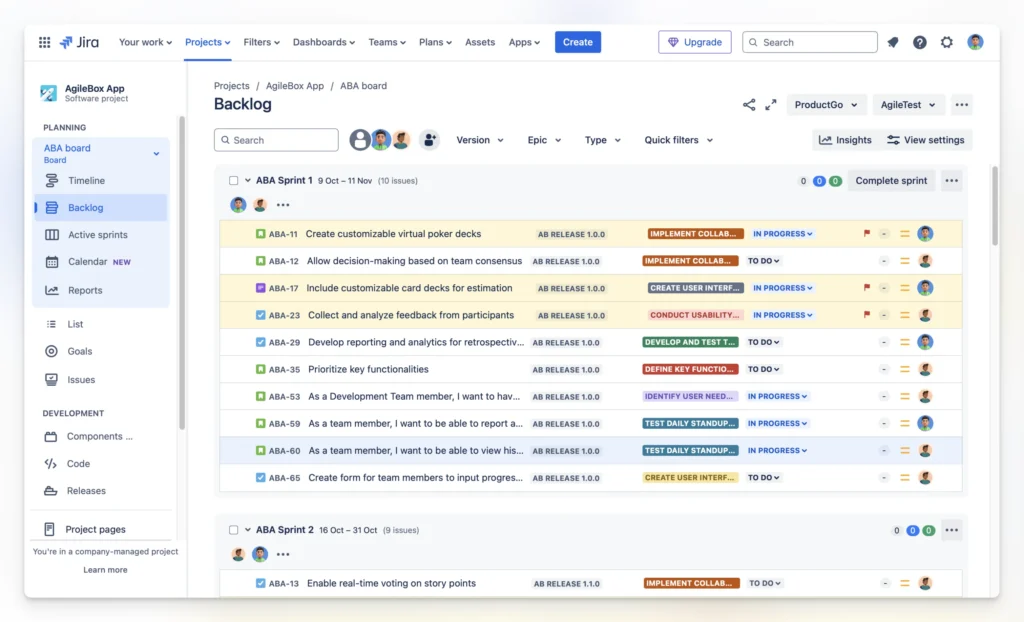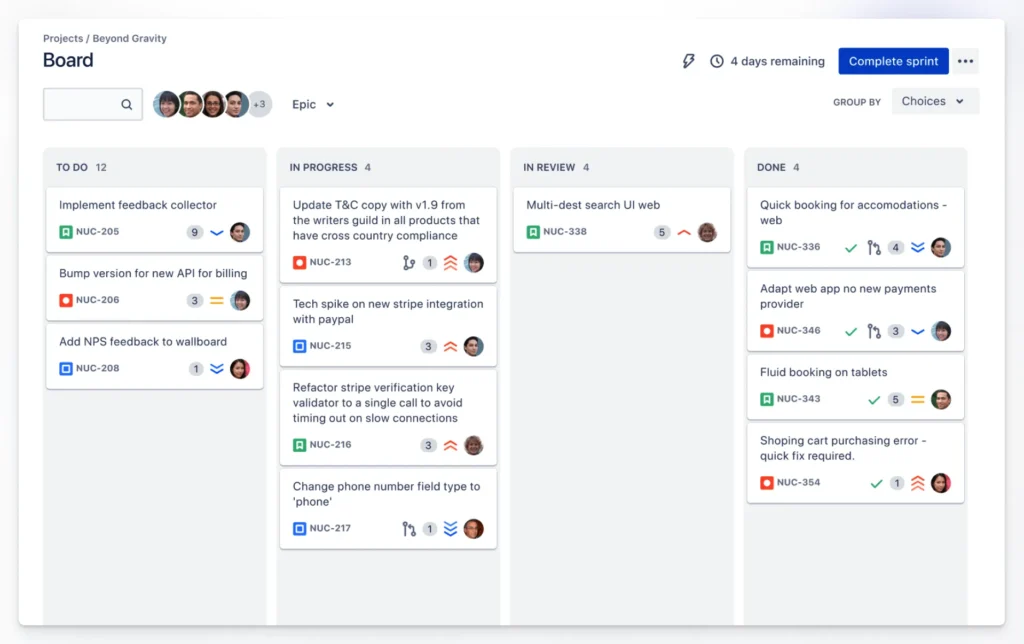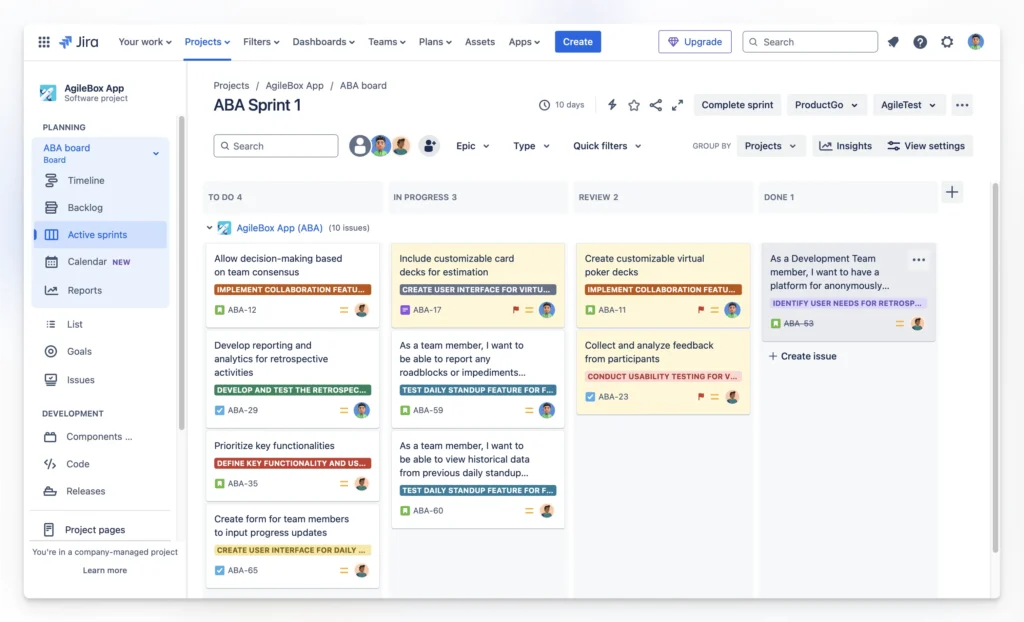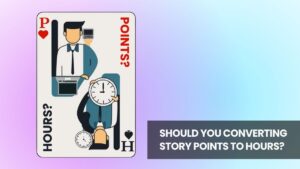Effective team capacity planning is important for any team’s success. AgileBox’s planning poker feature provides teams with a collaborative estimation tool that helps organize workload and plan resources efficiently.
Understanding Team Capacity Planning
Team capacity planning helps teams manage workload and meet project deadlines. Development teams, Product Management teams, and Business teams all need capacity planning to track their projects, coordinate between team members, and organize deliverables effectively.
Teams need to know their available work hours, team skills, meeting schedules, and keep extra time for unexpected work. Poor planning leads to team burnout, late deliveries, and lower-quality work. These problems affect both the project results and team performance, which is why teams need a clear way to manage their workload.
Planning Poker: A Collaborative Estimation Technique
Planning poker lets team members estimate tasks together using numbered cards. Each person picks a card to show how much work they think a task needs. After each team member picks their card, the numbers are shown all at once. If the estimates are different, the team talks about why they chose those numbers. This helps teams understand the task better and agree on how much work it needs.

AgileBox’s online version works for both office and remote teams, making it easy for everyone to join in.
Key benefits of planning poker include:
- Fair Estimates: Showing all numbers at once stops team members from copying others
- Everyone Participates: Each team member shares their view of the task
- Find Problems Early: Different estimates often point out hidden issues or risks
- Clear Size Guide: Using Fibonacci numbers (1, 2, 3, 5, 8, 13, 21) helps teams measure tasks better
Step-by-Step Guide to Team Capacity Planning with AgileBox
1. Task breakdown and preparation
A successful planning poker session starts with good preparation. In AgileBox, create clear and detailed tasks in your Jira board. Each task should include user stories, acceptance criteria, and any relevant technical requirements. This helps team members understand exactly what they’re estimating.

Before the session:
- Schedule a time when all team members can attend
- Send calendar invites with the AgileBox planning poker session link
- Give team members time to review the tasks beforehand
- Assign a moderator to guide the session
2. Customize your planning poker deck
AgileBox lets you customize card decks to match how your team thinks about task sizing. While the Fibonacci sequence (1, 2, 3, 5, 8, 13, 21) is popular, your team might prefer T-shirt sizes (XS, S, M, L, XL) or powers of 2 (1, 2, 4, 8, 16).
Make estimation more effective by adding special cards:
- “?” – For when a story needs more clarity
- “Coffee Break” – Signal when the discussion gets stuck
- “Too Big” – Indicate that a story should be split
- “0” – Tasks requiring minimal effort

Setting up your custom deck in AgileBox takes just a few clicks through the planning poker settings menu. You can always adjust your deck as your team’s needs change.
→ Discover more details on how you can customize your own planning poker deck.
The value of each card will be determined by the story point. Users can decide to match it with their desired field in Jira.
3. Running the estimation session
Start your session by having the moderator present each issue from your backlog. AgileBox shows the task description, acceptance criteria, and any attached files directly in the planning poker interface.
The estimation process for each task follows these steps:
- The moderator presents the task and answers initial questions
- Team members privately choose their estimates
- Everyone reveals their cards simultaneously in AgileBox
- The system shows all votes and calculates the average

If estimates vary widely, AgileBox makes it easy to have a productive discussion:
- High and low estimators explain their thinking
- Team members can add comments directly to the tool
- The moderator can guide the discussion toward a consensus
- All discussion points are automatically saved for future reference
When a task is too large:
- Use the “Split” feature in AgileBox to break it down
- Create smaller, manageable sub-tasks
- Re-estimate each new sub-task
- AgileBox maintains links between split stories automatically
4. Assess your team’s capacity
After completing the estimation in planning poker, use Jira’s built-in tools to manage your team’s capacity. In Jira:
- Check team workload through the Sprint board
- View team members’ availability in the Team Calendar
- Track story points per sprint using Velocity Charts
- Monitor sprint burndown to understand team capacity

Remember to account for regular commitments in Jira when planning:
- Team meetings and ceremonies
- Planned leave and holidays
- Required administrative tasks
- Training sessions
5. Allocate tasks in Jira
Once planning poker estimates are synchronized with your Jira issues, use Jira’s sprint planning features to distribute work effectively:
- Drag issues into your sprint based on priority
- Assign tasks to team members through the board view
- Set up Epics and create issue links to manage dependencies
The story point estimates from planning poker sessions help you make informed decisions about how many tasks to include in each sprint.

6. Monitor progress in Jira
Track your team’s progress using Jira’s reporting tools:
- Use Sprint Reports to compare estimated vs actual completion
- Check Burndown Charts for sprint progress
- Review Velocity Charts to understand team capacity
- Analyze Sprint Reports during retrospectives which are also included in AgileBox
These metrics help your team improve estimation accuracy over time. While AgileBox planning poker handles the estimation process, Jira provides the tools to track and adjust your team’s performance throughout the sprint.

Remember that good estimation through planning poker combined with Jira’s tracking features helps teams deliver more predictable results. Use the data from both tools to continuously refine your planning process.
Best Practices when Using AgileBox’s Planning Poker for Jira
Make your Planning Poker sessions more effective with these key practices:
- Involve Your Whole Team: Include everyone from developers to product owners in estimation sessions to get diverse perspectives and more accurate estimates.
- Review Stories First: Always discuss and clarify user stories with your team before starting the estimation process.
- Keep Estimation Simple: Use basic Fibonacci numbers and focus on relative sizing rather than seeking perfect estimates.
- Encourage Open Discussion: Create a comfortable environment where team members can freely share their thoughts and concerns about estimates.
- Stay Consistent: Maintain regular estimation sessions and document the reasoning behind estimates for future reference.
Conclusion
AgileBox Planning Poker helps teams estimate work more accurately through collaboration. By combining structured estimation with Jira’s project management features, teams can better plan their sprints and deliver more predictable results.
The tool works best when teams commit to regular practice and open communication. Start with these guidelines, adjust them to fit your team’s needs, and use the feedback from each sprint to improve your estimation process.




